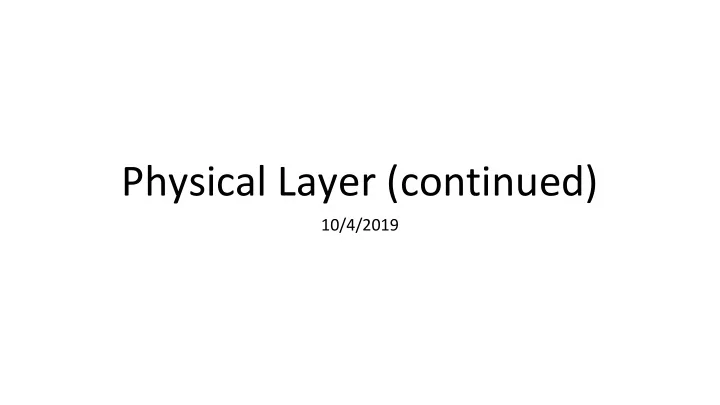

Physical Layer (continued) 10/4/2019
Topics 1. Coding and Modulation schemes Wednesday’s • Representing bits, noise Class 2. Properties of media • Wires, fiber optics, wireless, propagation • Bandwidth, attenuation, noise 3. Fundamental limits • Nyquist, Shannon CSE 461 University of Washington 2
Warning! Brief Review! Where we are ● Working our way up the stack starting with the Physical layer Made of up physical things Application - wires Transport - fiber Network - electromagnetic waves/light Link Physical CSE 461 University of Washington 3
Warning! Brief Review! Philosophical Takeaways ● Everything is analog, even digital signals ● Digital information is a discrete concept represented in an analog physical medium ○ A printed book (analog) vs. ○ Words conveyed in the book (digital) CSE 461 University of Washington 4
Warning! Brief Review! Types of Media ● Media propagate analog signals that carry bits of digital information ● We looked at some common types... ??? What are some examples??? ○ Copper Wires (twisted pair | coax) ○ Fiber (fiber optic cables) ○ Wireless CSE 461 University of Washington 5
What is the difference between light, radio waves, and gamma radiation?
Well … only one makes the Hulk Photo credit Marvel via topmovieclips.com
They are all the same thing (electromagnetic radiation) at different frequencies …
Different frequencies have different properties! Not all frequencies are created equal... wikimedia commons
Warning! Brief Review! WiFi WiFi CSE 461 University of Washington 10
Theoretical Limits “Information Theory”
Real World Limits ● How rapidly can we send information over a link? ○ Nyquist limit (~1924) ○ Shannon capacity (1948) ● Practical systems (I.E. your cellphone) approach these limits! Pretty cool : ) CSE 461 University of Washington 12
Warning! Brief EE Moment! Analog Vocabulary Again ● Often easier to think about signals in frequency 13 Attribution: Pbchem at en.wikipedia
Warning! Brief EE Moment! Important Analog Vocabulary (2) ● Every analog signal has a given bandwidth CSE 461 University of Washington 14 Attribution: Henrikb4 at en.wikipedia
Key Channel Properties ● The bandwidth (B), signal power (S), and noise power (N) ○ B (in hertz) limits the rate of transitions ○ S and N (in watts) limit how many signal levels we can distinguish Bandwidth B Signal S, Noise N CSE 461 University of Washington 15
Warning! Brief EE Moment! What is the bandwidth of a square wave? Amplitude Time Infinite! No true square wave exists in the real world CSE 461 University of Washington 16 Attribution: Henrikb4 at en.wikipedia
Warning! Brief EE Moment! CSE 461 University of Washington 17 Attribution: captainprog at dsp.stackexchange.com
Brief Activity...
Nyquist Limit ● The maximum symbol rate is 2*Bandwidth 1 0 1 0 1 0 1 0 1 0 1 0 1 0 1 0 1 0 1 ● Thus if there are V signal levels, ignoring noise, the maximum bit rate is: R = 2B log 2 V bits/sec CSE 461 University of Washington 19
Claude Shannon (1916-2001) •Father of information theory • “A Mathematical Theory of Communication”, 1948 •Fundamental contributions to digital computers, security, and communications Electromechanical mouse that “solves” mazes! Credit: Courtesy MIT Museum CSE 461 University of Washington 20
Shannon Capacity • How many levels we can distinguish depends on S/N • Or SNR, the Signal-to-Noise Ratio S+N • Note noise is random, hence some errors 0 N • SNR given on a log-scale in deciBels: 1 • SNR dB = 10log 10 (S/N) 2 3 CSE 461 University of Washington 21
Shannon Capacity (2) • Shannon limit is for capacity (C), the maximum lossless information carrying rate of the channel: C = B log 2 (1 + S/N) bits/sec • Deriving this is outside the scope of this course, but it is an elegant result with incredible implications... CSE 461 University of Washington 22
Shannon Capacity Takeaways C = B log 2 (1 + S/N) bits/sec • There is some rate at which we can transmit data without loss over a random channel • Assuming noise fixed, increasing the signal power yields diminishing returns : ( • Assuming signal is fixed, increasing bandwidth increases capacity linearly! CSE 461 University of Washington 23
No matter what fancy code you use, you can’t beat Shannon (in AWGN) NRZ signal of bits Amplitude shift keying Frequency shift keying Phase shift keying CSE 461 University of Washington 24
Wired/Wireless Perspective •Wires, and Fiber • Engineer link to have requisite SNR and B → Can fix data rate Engineer SNR for data rate •Wireless • Given B, but SNR varies greatly, e.g., up to 60 dB! → Can’t design for worst case, must adapt data rate Adapt data rate to SNR ??? Which is better ??? CSE 461 University of Washington 25
There is no magic 5G... ● To increase the data rate, you need either more spectrum or more power ● Both are limited by physics … how can we work around it???
“Spatial Reuse” medium.com/@artiedarrell
govtech.com Make the cells smaller … so we can have more of them!
Phy Layer Innovation Still Happening! ● Backscatter “zero power” wireless ● mm wave 30GHz+ radio equipment ● Free space optical ( FSO ) ● Cooperative interference management ● Massive MIMO and beamforming ● Powerline Networking ● 100 GbE in datacetners, etc.
All distilled to a simple link model •Rate (or bandwidth, capacity, speed) in bits/second •Delay in seconds, related to length Message Delay D, Rate R •Other important properties: • Whether the channel is broadcast, its error rate, and its stability CSE 461 University of Washington 31
Recommend
More recommend